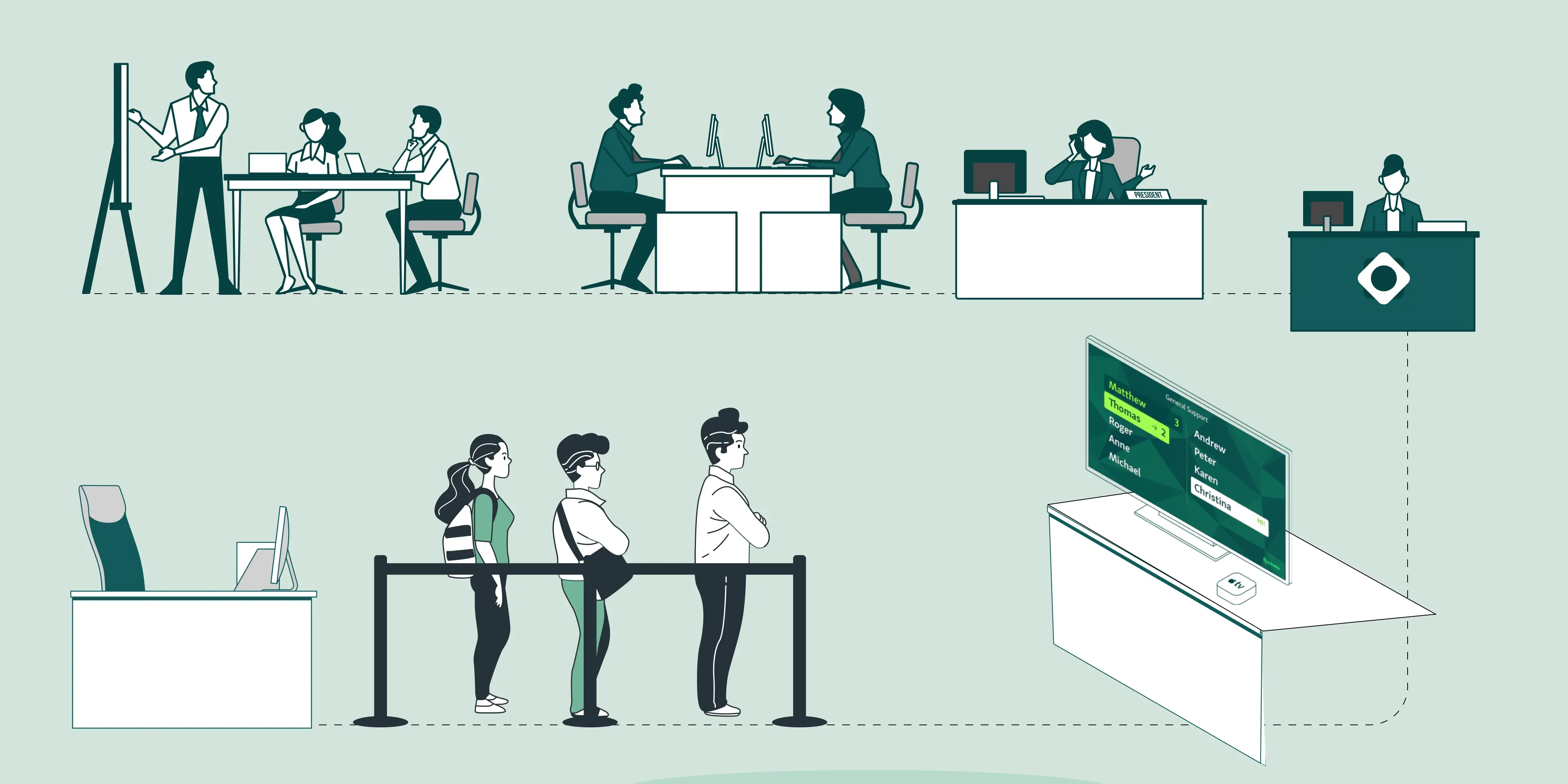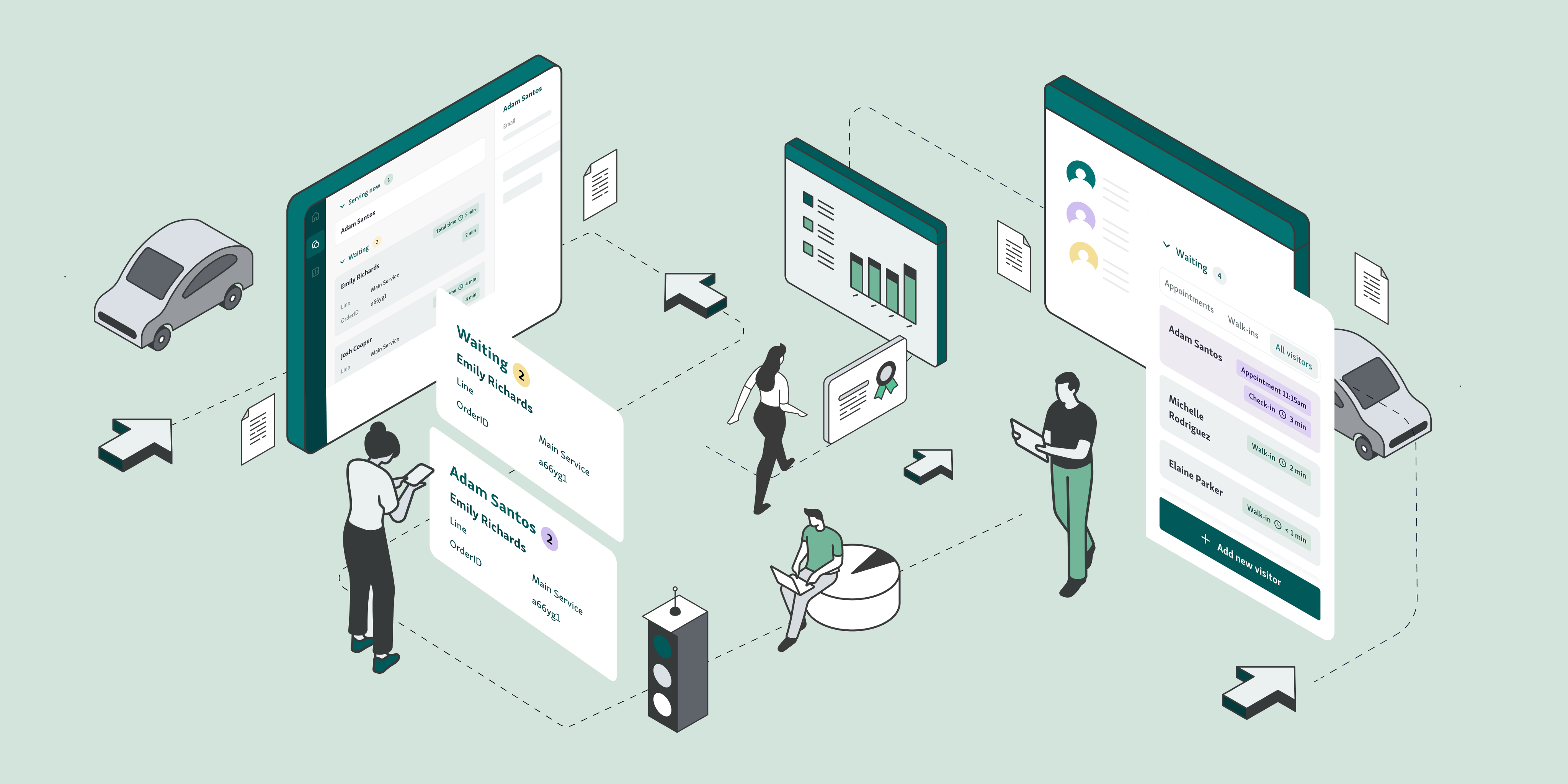Local governments face increasing pressure to deliver efficient and timely services to their citizens. One of the key factors influencing service quality is citizen flow—the process through which individuals move through public service facilities.
Smooth citizen flow is crucial, as it helps reduce congestion, better manage waiting times, and improves the overall experience for citizens. Improving citizen flow directly impacts service efficiency, reduces wait times, and enhances overall satisfaction.
Optimizing this flow not only ensures smoother operations but also translates into measurable ROI by lowering operational costs and enhancing resource allocation.
By prioritizing efficient citizen movement, local governments can allocate resources more effectively and streamline service delivery.
This blog explores how improving citizen flow can boost both service quality and cost-effectiveness in local governments.
What Disrupts Citizen Flow in Local Governments
Citizen flow refers to how smoothly individuals move through various government services—such as applying for permits, paying bills, or seeking assistance—whether in-person or online. A seamless citizen flow means shorter wait times, less confusion, and a better overall experience.
Several factors can significantly hinder the smooth movement of citizens through local government services, leading to inefficiencies, delays, and dissatisfaction. Key disruptions include:
1. Overcrowding and Long Wait Times that Create Service Delays
Overcrowding in government offices often results in long wait times, which frustrate citizens and impact the quality of service. Long queues, especially during peak hours, create stress for citizens and staff alike, leading to a negative experience and potential decline in public trust. Delays not only frustrate citizens but also reduce overall service delivery capacity.
You might also like : 7 Insanely Powerful Strategies to Manage Customer Wait Times
2. Inefficient Resource Allocation that Leads to Bottlenecks
When resources—such as staff, office space, or technology—are poorly allocated, bottlenecks form within the system. For instance, understaffed service counters or poorly distributed appointment slots can slow down the entire process, increasing wait times and creating inefficiencies. Such resource mismanagement directly affects the flow of citizens and contributes to operational disruptions.
3. Lack of Streamlined Processes that Hinder Efficient Service Delivery
Without a well-organized, streamlined process in place, citizens experience confusion and delays. This can be due to outdated systems, lack of clear signage, or ineffective workflow management. The absence of standardized procedures means longer processing times for each citizen, leading to a chaotic environment where service delivery is disjointed and inefficient.
How Better Citizen Flow Translates into Better ROI
Improving citizen flow not only enhances service quality but also directly translates into measurable return on investment (ROI) for local governments. When local governments streamline citizen flow, the result is optimized operational costs, reduced resource wastage, and better overall efficiency.
Here’s a deeper look at how these improvements lead to better ROI:
1. Shorter Wait Times Reduce the Need for Excessive Staff, Lowering Labor Costs
One of the most significant cost savings comes from reducing wait times, which directly impacts the need for staff. When citizens can schedule appointments or check-in remotely, there are fewer people waiting in line, and the staff required to manage that line decreases. As a result, local governments can optimize their workforce and lower labor costs.
For instance, by improving citizen flow and reducing wait times by just 10-15 minutes per visit, an office with 10 full-time employees may save approximately 10% in labor costs.
Let’s consider a scenario where each staff member’s annual salary is $50,000. By reducing the need for excess staffing during peak hours, local governments could save up to $50,000 annually in labor expenses.
Not only does this create a more efficient service, but it also ensures that resources are allocated more effectively without compromising the quality of service provided to citizens.
2. Less Crowded Spaces Lead to Lower Facility Management and Maintenance Expenses
A smooth, efficient citizen flow leads to less overcrowding, which in turn reduces the wear and tear on public facilities. With fewer people in physical spaces at any given time, the need for intensive cleaning, maintenance, and utilities decreases significantly.
By managing citizen flow more effectively, local governments can reduce facility-related costs, such as cleaning, maintenance, and utilities, by up to 15%.
For example, if a public service office spends around $50,000 annually on facility maintenance, the optimization of citizen flow could save approximately $7,500 per year. This saving occurs because fewer visitors in the building reduce the need for frequent cleaning, HVAC usage, and additional maintenance services.
These cost savings, when compounded across multiple government offices, can lead to significant financial relief for local governments struggling with tight budgets.
3. Pre-Scheduled Appointments Enable Better Resource Allocation, Cutting Waste
Pre-scheduled appointments help local governments allocate resources more efficiently—staff, office space, and equipment. Without proper scheduling, teams may be underutilized or overwhelmed.
Qminder supports this with Service Intelligence tools that provide real-time data on visitor volumes, peak hours, and service demand. Dashboards like Visitor Volumes and Average Hourly Visits help offices anticipate busy periods and staff accordingly.

For example, a local office with a $60,000 labor budget could save up to $6,000 annually by eliminating just 10% of idle time. Qminder also tracks sign-in channels, helping optimize staffing between front-desk and service areas. The result: less waste, better service, and smarter resource use.
Helpful read: Staffing & Scheduling With a Queue Management System
4. Improved Citizen Flow and Service Data Equals Greater Financial Efficiency
Improving citizen flow within local government services offers clear financial benefits. Reduced wait times, better facility usage, and smarter resource allocation lead to lower operational costs and improved ROI.
But it’s not just about managing queues—it’s also about understanding them. Service data, such as how many visitors come in for each service and when, can inform broader delivery strategies.
For example, if a large number of citizens visit on Monday mornings to renew permits, DMV offices can plan ahead by opening more service lines or adjusting staffing—reducing congestion and improving service quality.
While tools like appointment scheduling and queue management systems may require upfront investment, the long-term gains in efficiency, cost savings, and citizen satisfaction make them well worth it.
Simple Ways to Improve Citizen Flow in Local Governments
To enhance the efficiency and satisfaction of public services, local governments can adopt a range of strategies to improve citizen flow. These strategies are designed to reduce wait times, optimize resource use, and ensure smoother operations across service delivery points.
1. Implementing Appointment Queue Software
Appointment scheduling software plays a critical role in managing citizen flow. By allowing citizens to book appointments ahead of time, local governments can better manage peak hours, avoid overcrowding, and prevent long waiting periods.

Appointment systems also allow for the precise allocation of resources, such as staff and facilities, at scheduled times, leading to a more efficient and predictable service environment.
Citizens can schedule their visits in advance, reducing uncertainty and wait times.
Peak hours can be identified and managed proactively.
Resources like staff and rooms can be allocated more effectively based on demand.
Read more - How Electronic Queuing Systems Improve Operational Efficiency
2. Use of Real-Time Notifications and Automated Reminders
Real-time notifications and automated reminders significantly enhance citizen engagement and minimize no-shows. By keeping citizens informed about their appointment status, wait times, or any changes to their bookings, these tools help manage expectations and reduce frustration.
Automated reminders via SMS or email can further reduce instances of missed appointments, leading to better time management for both citizens and government staff.

Real-time updates ensure citizens are aware of any delays or changes.
Automated reminders reduce the number of missed appointments.
Citizens can adjust their schedules based on real-time information.
Also Read - How to set real-time notifications
3. Optimizing Physical Space and Resource Allocation
Efficient use of physical space and resources is crucial to improving citizen flow. This can involve organizing waiting areas to minimize congestion, strategically placing service counters, and ensuring that staff are adequately distributed across various service points.
Optimizing resources also involves tracking high-demand times and adjusting staffing levels to ensure that sufficient personnel are available to handle citizen requests promptly.
Organizing waiting areas reduces overcrowding and improves comfort.
Service counters should be well distributed to avoid bottlenecks.
Staffing adjustments based on demand ensure efficient service delivery.
4. Integrating Technology for Smoother Interactions
Embracing technology like Qminder’s mobile check-ins and self-service kiosks enhances citizen interaction with government services. These technologies allow citizens to check in remotely, either before arriving or upon entering the facility, reducing bottlenecks at the registration counters.
Self-service kiosks enable citizens to complete tasks like filling out forms, paying fees, or checking the status of their requests, streamlining operations and reducing the burden on staff. Additionally, mobile apps and other technology solutions allow for faster, more efficient citizen-government interactions, improving overall satisfaction and efficiency.
Mobile check-ins allow citizens to bypass long queues.
Self-service kiosks help citizens complete tasks independently.
Technology-driven solutions speed up administrative processes and reduce human errors.
The Long-Term Benefits of Improving Citizen Flow
Improving citizen flow within local government offices provides a range of long-term advantages, such as fostering public trust, increasing transparency, and optimizing operational costs. These benefits extend beyond short-term efficiency gains, creating lasting value for both citizens and the government.
1. Enhanced Public Trust and Engagement
When citizens experience smoother, more efficient services, frustration is reduced, and trust in local government grows. A streamlined citizen flow encourages greater public engagement, leading to increased participation in community initiatives and positive feedback on government services.
2. Increased Transparency and Accessibility
Implementing tools like online scheduling and real-time notifications enhances transparency and makes services more accessible. Citizens can plan their visits more effectively, reducing the need for unnecessary trips and empowering them to manage their interactions with government services.
3. Long-Term Cost Savings Through Process Optimization
Efficiently managing citizen flow translates into significant long-term savings. By optimizing resource allocation, local governments can reduce staffing costs, minimize facility maintenance, and avoid underutilizing resources. This means funds can be redirected to other essential services, improving overall public sector efficiency.
You might also like: 9 Proven Benefits of Online Queue Management Systems
Local governments can measure the impact of improved citizen flow through various performance indicators such as reduced wait times, faster service delivery, and higher citizen satisfaction ratings. Tracking appointment no-show rates, service times, and staff productivity are also valuable metrics. By comparing these metrics before and after implementing changes, governments can determine how much more efficient their services have become.
One cost-effective solution for optimizing citizen flow is implementing appointment scheduling and queue management systems. Tools like Qminder allow governments to efficiently manage citizen appointments, reduce overcrowding, and optimize staff allocation. These solutions eliminate the need for excessive physical space, streamline operations, and cut down on manual work, all of which contribute to reducing operational costs.
When selecting a system to improve citizen flow, key factors to consider include ease of use, integration with existing systems, and scalability. The system should be capable of handling peak hours and offer features like automated reminders, real-time updates, and mobile check-ins. It's also important to consider a system's adaptability to different service environments and its ability to provide insights through data analytics to continuously optimize the process.
How Local Governments Can Get Started
Improving citizen flow is a powerful way for local governments to enhance service delivery, reduce operational costs, and build trust within their communities.
To begin, governments should evaluate their current challenges and determine the specific needs that appointment queue software can address. It’s essential to select tools that integrate well with existing systems, offer ease of use, and support scalability for future growth.
Engaging with experts who can guide the implementation ensures smooth and effective adoption.
By choosing the right solutions, like Qminder, local governments can optimize citizen flow, enhance satisfaction, and ultimately improve service efficiency while driving measurable ROI.






